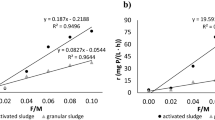Abstract
The behavior of six heavy metals in an activated sludge pilot plant under conditions of normal and elevated influent metal concentrations has been studied. Percentage heavy metal removals at sludge ages of 4, 9, and 12 d were more consistent when metals were added to the system, possibly as a result of lesser variations in heavy metal speciation in the settled sewage, and the greatest degree of accumulation of heavy metals by the biomass occurred at the 12 d sludge age. When shock loads of heavy metals were introduced into the system, their concentrations in the effluent did not immediately rise in proportion; however, heavy metal removal efficiencies were similar under steady state conditions of normal and elevated influent metal concentrations. Cadmium, Cu, and Ni were largely soluble in the effluent samples, but Cr, Pb, and Zn were predominantly insoluble, indicating that particulate forms of these metals may escape removal in secondary sedimentation. The high degree of Ni solubility in the settled sewage and final effluent reflected its consistently poor removal in the process. The two most soluble metals, Cu and Ni, appeared to be associated to a large degree with high molecular weight substances in the settled sewage and final effluent, possibly influencing their availability for uptake by the biomass.
Similar content being viewed by others
References
Barnes, D., Cooksey, B. G., Metters, B., and Metters, C.: 1975, J. Water Treat. Exam. 24, 318.
Baskir, C. L. and Hansford, G. S.: 1980, Biotechnol. Bioeng. 22, 1857.
Bender, M. E., Matson, W. R., and Jordan, R. A.: 1970, Environ. Sci. Technol. 4, 520.
Brewin, D. J. and Hellawell, J. M.: 1980, ‘A Water Authority Viewpoint on Monitoring’, Chem. Ind. 595–600.
Brown, H. G., Hensley, C. P., McKinney, G. L., and Robinson, J. L.: 1973, Environ. Lett. 5, 103.
Brown, M. J. and Lester, J. N.: 1979, Water Res. 13, 817.
Carrondo, M. J. T., Perry, R., and Lester, J. N.: 1980, J. Water Pollut. Contr. Fed. 52, 2796.
Casey, J. D. and Wu, Y. C.: 1977, ‘Removal of Copper and Cadmium by Metabolically Controlled Activated Sludge’, Proc. 32nd Ind. Waste Conf., Purdue Univ. 141–152.
Chen, K. Y., Young, C. S., and Rohatgi, N.: 1974, J. Water Pollut. Contr. Fed. 46, 2663.
Cheng, M. H., Patterson, J. W., and Minear, R. A.: 1975, J. Water Pollut. Contr. Fed. 47, 362.
Davis, J. A. and Jacknow, J.: 1975, J. Water Pollut. Contr. Fed. 47, 2293.
Esmond, S. E. and Petrasek, A. C.: 1974, Ind. Water Eng. 11, 14.
European Economic Community: 1975, ‘Council Directive Concerning the Quality of Water Intended for the Abstraction of Drinking Water in the Member States (75/440/EEC)’, Off. J. Eur. Communities, L194/26L194/31.
Florence, T. M.: 1977, Water Res. 11, 681.
Government of Great Britain, Department of the Environment: 1972, Analysis of Raw, Potable and Waste Waters, HMSO, London.
Kunz, R. G., Gianelli, J. F., and Stensel, M. P.: 1976, J. Water Pollut. Contr. Fed. 48, 762.
Lamb, A. and Tollefson, E. L.: 1973, Water Res. 7, 599.
Lester, J. N., Harrison, R. M., and Perry, R.: 1979, Sci. Total Environ. 12, 13.
Lewin, B. H. and Rowell, M. J.: 1973, Eff. Water Treat. J. 13, 273.
Oliver, B. G. and Cosgrove, E. G.: 1974, Water Res. 8, 869.
Roberts, P., Hegi, H. R., Webber, A., and Kradhenbähl, H. R.: 1977, Prog. Water Technol. 8, 301
Sterritt, R. M. and Lester, J. N.: 1980, Environ. Technol. Lett. 1, 402.
Sterritt, R. M. and Lester, J. N.: 1981, Water Res. 15, 59.
Sterritt, R. M. and Lester, J. N.: 1982, Environ. Pollut. (Ser. A) 27, 37.
Sterritt, R. M., Brown, M. J., and Lester, J. N.: 1981, Environ. Pollut. (Ser. A) 24, 313.
Stones, T.: 1955, ‘The Fate of Chromium During the Treatment of Sewage’, Inst. Sewage Purif. 345–347.
Stones, T.: 1958, ‘The Fate of Copper During the Treatment of Sewage’, Inst. Sewage Purif. 82–83.
Stones, T.: 1959a, ‘The Fate of Nickel During the Treatment of Sewage’, Inst. Sewage Purif. 252–254.
Stones, T.: 1959b, ‘The Fate of Zinc During the Treatment of Sewage’, Inst. Sewage Purif. 254–257.
Stones, T.: 1960, ‘The Fate of Lead During the Treatment of Sewage’, Inst. Sewage Purif. 221–223.
Stoveland, S. and Lester, J. N.: 1980, Sci. Total Environ. 16, 37.
Stoveland, S., Astruc, M., Lester, J. N., and Perry, R.: 1979, Sci. Total Environ. 12, 25.
World Health Organisation: 1970, European Standards for Drinking Water, 2nd ed., Geneva.
World Health Organisation: 1971, International Standards for Drinking Water, 3rd ed., Geneva.
Author information
Authors and Affiliations
Additional information
To whom all correspondence should be addressed.
Rights and permissions
About this article
Cite this article
Rossin, A.C., Sterritt, R.M. & Lester, J.N. The influence of process parameters on the removal of heavy metals in activated sludge. Water Air Soil Pollut 17, 185–198 (1982). https://doi.org/10.1007/BF00283301
Received:
Revised:
Issue Date:
DOI: https://doi.org/10.1007/BF00283301




